Do you have a question about the Linhai LH40DA and is the answer not in the manual?
Critical safety advice for modifications, aftermarket parts, and warranty.
Guidelines for safe and responsible ATV operation, respecting rules and environment.
Explains warning symbols and signal words like WARNING, CAUTION, and NOTE.
Details warnings on vehicle misuse, towing limits, and age restrictions for operation.
Covers warnings about high voltage, load capacity, tire pressure, and hot surfaces.
Provides warnings on battery charging safety, acid hazards, and proper handling procedures.
Details warnings on safe ATV use, passenger requirements, and proper riding practices.
Recommends professional dealer inspection after a rollover or accident.
Highlights the need for good judgment and physical skills for safe operation.
Warns against operating on extreme terrain, slopes, or jumping due to high risk.
Check tire condition and pressures before each ride for safety.
Check batteries and charge them to ensure proper power.
Inspect brake fluid, operation, and check for leaks.
Ensure smooth operation, closing, and freeplay of the throttle pedal.
Verify operation of headlights, taillights, brake lights, and switches.
Check the proper function of the motor stop switch.
Inspect wheel tightness, bearing condition, and steering for looseness or noise.
Visually inspect for damaged components or loose nuts/bolts.
Ensure helmets, goggles, and clothing are appropriate for safe riding.
Check seat belts for proper operation, wear, and secure latching.
Warning about potential hazards from a malfunctioning accelerator pedal.
Alert to the danger of operating with a loose seat, leading to loss of control.
Emphasizes the risk of severe injury or death from not wearing seat belts properly.
Warns against stopping tipping vehicle with limbs; risk of severe injury.
Caution regarding pinch points when lowering the cargo bed.
Warns that overloading the cargo bed affects handling and stability.
Prohibits carrying passengers in the cargo bed due to fall risk.
Highlights risks of uneven shock absorber adjustment affecting handling.
Warns against operating with improperly functioning brakes.
Stresses the importance of understanding all controls to prevent loss of control.
Caution about freezing control cables in cold weather affecting vehicle control.
Warns about consequences of improper vehicle loading or towing.
Advises against improper installation of accessories or modifications.
Warns about risks associated with improperly serviced or adjusted brakes.
Alerts to the dangers of damaged control cables restricting operation.
Details hazards of battery electrolyte (acid) and explosive gases.
Caution about using incorrect fuses, which can lead to electrical system damage or fire.
Warns about the heat of headlight bulbs and potential burn/fire risk.
Advises testing brakes after washing due to reduced stopping ability.
Emphasizes wearing helmets, eye protection, and protective clothing for safety.
Prohibits operating the ATV under the influence of alcohol or drugs.
Warns against operating at excessive speeds, increasing loss of control risk.
Discourages stunts like wheelies and jumps due to accident risk.
Highlights risks of not inspecting or maintaining the ATV before operation.
Advises keeping hands on handlebars and feet on footrests during operation.
Stresses extra care when operating on unfamiliar terrain.
Warns about risks of operating on challenging terrain without proper skills.
Details dangers of improper hill climbing techniques, risking overturn.
Warns against improper turning, which can cause loss of control or overturn.
Advises against operating on excessively steep hills due to overturn risk.
Provides guidance on safe downhill travel to prevent loss of control or overturn.
Warns about dangers of improperly crossing or turning on hills.
Addresses risks of stalling or rolling backward while climbing hills.
Caution about operating over obstacles, risking loss of control or overturn.
Warns about losing control due to skidding or sliding on slippery surfaces.
Warns about risks from using improper tires or incorrect tire pressure.
Warns against riding on frozen bodies of water due to ice break-through risk.
Instructions on recording Frame VIN and Motor Serial Number for identification.
Warning against turning the key to 'OFF' while the ATV is in motion.
Details the functions and indicators of the ATV's LCD meter.
Alerts to dangers of sticking or improperly operating throttle controls.
Explains the operation of the throttle lever and its spring-loaded mechanism.
Instructions for checking brake fluid levels in reservoirs before riding.
Describes how the front and rear brakes are operated and tested.
Warns against operating with a spongy brake pedal, which indicates braking loss.
Provides steps for setting and releasing the parking brake.
Important safety notes regarding parking brake use and limitations.
Explains the function and cautions for using the auxiliary brake.
Identifies the location and function of the brake fluid level indicator.
Details how to check brake fluid level in the master cylinder.
Caution to ensure the operator's seat is completely secured before riding.
Explains how to operate the transmission selector lever.
Warns against shifting selector while motor is rotating or vehicle is moving.
Warns about engaging lower gear at high engine speed, risking control loss.
Highlights the helmet as the most important piece of protective gear for preventing head injury.
Recommends goggles or face shields for optimal eye protection.
Specifies off-road style gloves and strong over-the-calf boots for protection.
Advises wearing long sleeves, pants, and optional padding for body protection.
Recommends 1/3 front, 2/3 rear distribution for stability.
Specifies maximum trailer and vertical hitch weight limits.
Warns against obstructing the headlight beam with cargo.
Recommends low forward gear for heavy pulling to extend belt life.
Caution that heavy loads can cause braking and control issues.
Emphasizes that all loads must be secured before moving the vehicle.
Advises carrying loads as low as possible to maintain stability.
Recommends operating only with stable, safely arranged, and centered loads.
Warns that loads extending over rack sides can cause overturn.
Instructs not to block headlights, taillights, or reflectors with cargo.
Specifies speed limits when towing loads in various conditions.
Explains the purpose and correct use of a safety chain for towing.
Notes that this vehicle handles differently from standard cars.
Reiterates the requirement for driver and passenger to wear seat belts.
Provides a step-by-step guide for starting and operating the vehicle.
Advises on experience needed before carrying passengers and capacity limits.
Details how to stop the vehicle, set the park brake, and turn off the engine.
Explains techniques for making turns smoothly, including leaning.
Warns against sharp angles when turning in reverse due to overturn risk.
Provides precautions for riding on slippery surfaces like wet trails or ice.
Details safe techniques for traveling uphill, including weight transfer.
Advises caution and avoidance of sidehilling due to its inherent dangers.
Provides guidance on safe downhill travel to prevent loss of control or overturn.
Describes the K-turn maneuver for turning around while climbing a hill.
Provides steps for safely crossing water bodies up to 8 inches deep.
Emphasizes staying alert for hazards like logs, rocks, and branches on trails.
Warns about invisible obstacles on trails, risking severe injury or death.
Provides precautions for backing up, including avoiding steep inclines and sharp turns.
Warns about excessive throttle causing fuel buildup, popping, and fire risk.
Illustrates parking on an incline and mentions related warnings.
Details steps for parking the vehicle, including securing it on inclines.
Instructions for safely disconnecting battery cables to prevent explosion.
Details the poisonous nature of battery electrolyte (sulfuric acid) and first aid.
Provides a step-by-step guide for removing the ATV battery.
Advises on cleaning up electrolyte spills with baking soda solution.
Specifies the correct order for connecting battery cables to prevent explosion.
Guidance on cleaning battery terminals and preventing corrosion.
Advises on proper storage of the battery for extended periods.
Explains how battery capacity increases with charge cycles.
Discusses how temperature affects battery range and discharge rate.
Warns about disconnecting the main power connector before other electrical components.
Advises on insulating tools in the battery area to prevent sparks or explosion.
Explains the color indications of the charge status indicator.
Suggests upgrading the battery for optional equipment needs.
Provides general precautions for handling batteries, including charging and cleaning.
Stresses the need for adequate ventilation during battery charging to prevent explosion.
Lists precautions for the battery charging area, avoiding sparks and flames.
Covers warnings about lead components, charging hazards, and electrolyte.
Details precautions for battery charging area, ventilation, and cord safety.
Guidance on cleaning battery terminals and when to replace the battery.
Information on battery disposal, recycling, and care of battery fluid.
Introduction to the periodic maintenance schedule for vehicle reliability.
Lists items for pre-ride and daily checks like brakes, tires, wheels, and headlamps.
Details maintenance intervals for battery terminals and brake pad wear.
Covers maintenance intervals for rear gear case oil and general lubrication points.
Details inspection and adjustment intervals for shift linkage and steering.
Covers inspection and lubrication intervals for front and rear suspension.
Maintenance intervals for shift selector box, brake fluid, and toe adjustment.
Specifies lubricant recommendations and maintenance for brake fluid and rear gear case oil.
Details lubrication points and intervals for A-arms and steering bushings.
Covers inspection and lubrication intervals for wheel bearings and tie rods.
Details lubrication for prop shafts, yokes, and throttle components.
Provides lubrication intervals for rear axle and swing arm bearings.
Provides definitions for grease types and notes on maintenance intervals.
A chart for recording periodic maintenance work performed.
Details the procedure for lubricating and changing rear gear case oil.
Instructions for adjusting handlebar height for personal fit.
Specifies torque values for front and rear wheel nuts.
Details front wheel bearing tightness and spindle nut retention service.
Covers periodic checks for loose nuts and bolts in the steering assembly.
States camber/caster are non-adjustable and warns against tie rod adjustment.
Explains how to check and adjust toe alignment for the ATV.
Recommends checks for fluid level, leaks, and pad wear in the front brake system.
Details checks for rear brake pads, disc wear, and auxiliary brake system.
Covers checking and adjusting the mechanical parking brake for proper function.
Provides a step-by-step guide for adjusting the mechanical parking brake.
Instructions for adjusting the free play of the throttle cable at the handlebar.
Warns about the effects of worn or improperly inflated tires on vehicle handling.
Details proper tire pressure and steps for wheel removal and installation.
Guidance on inspecting tires for wear and replacing them when tread is low.
Emphasizes keeping lights clean for visibility and safety.
Warns against servicing hot headlights and touching bulbs with bare fingers.
Recommends safe ways to clean the ATV, avoiding high-pressure systems.
Advises on waxing the ATV and avoiding harsh cleaners that can scratch the finish.
Caution about certain products damaging plastic surfaces.
Provides tips for ATV storage, including cleaning and fluid checks.
Details battery maintenance, storage area ventilation, and covers.
Outlines measures for safely transporting the ATV.
Lists the tools provided with the ATV, such as screwdrivers and wrenches.
Provides detailed dimensions, seat height, ground clearance, and load capacities.
Details specifications for the electric motor, front, and rear tires.
Outlines the types of brakes used, including service, parking, and auxiliary.
Describes the front and rear suspension types and shock absorbers.
Lists specifications for the battery, lights, and fuses.
Technical diagram illustrating the ATV's electrical system connections.
Critical safety advice for modifications, aftermarket parts, and warranty.
Guidelines for safe and responsible ATV operation, respecting rules and environment.
Explains warning symbols and signal words like WARNING, CAUTION, and NOTE.
Details warnings on vehicle misuse, towing limits, and age restrictions for operation.
Covers warnings about high voltage, load capacity, tire pressure, and hot surfaces.
Provides warnings on battery charging safety, acid hazards, and proper handling procedures.
Details warnings on safe ATV use, passenger requirements, and proper riding practices.
Recommends professional dealer inspection after a rollover or accident.
Highlights the need for good judgment and physical skills for safe operation.
Warns against operating on extreme terrain, slopes, or jumping due to high risk.
Check tire condition and pressures before each ride for safety.
Check batteries and charge them to ensure proper power.
Inspect brake fluid, operation, and check for leaks.
Ensure smooth operation, closing, and freeplay of the throttle pedal.
Verify operation of headlights, taillights, brake lights, and switches.
Check the proper function of the motor stop switch.
Inspect wheel tightness, bearing condition, and steering for looseness or noise.
Visually inspect for damaged components or loose nuts/bolts.
Ensure helmets, goggles, and clothing are appropriate for safe riding.
Check seat belts for proper operation, wear, and secure latching.
Warning about potential hazards from a malfunctioning accelerator pedal.
Alert to the danger of operating with a loose seat, leading to loss of control.
Emphasizes the risk of severe injury or death from not wearing seat belts properly.
Warns against stopping tipping vehicle with limbs; risk of severe injury.
Caution regarding pinch points when lowering the cargo bed.
Warns that overloading the cargo bed affects handling and stability.
Prohibits carrying passengers in the cargo bed due to fall risk.
Highlights risks of uneven shock absorber adjustment affecting handling.
Warns against operating with improperly functioning brakes.
Stresses the importance of understanding all controls to prevent loss of control.
Caution about freezing control cables in cold weather affecting vehicle control.
Warns about consequences of improper vehicle loading or towing.
Advises against improper installation of accessories or modifications.
Warns about risks associated with improperly serviced or adjusted brakes.
Alerts to the dangers of damaged control cables restricting operation.
Details hazards of battery electrolyte (acid) and explosive gases.
Caution about using incorrect fuses, which can lead to electrical system damage or fire.
Warns about the heat of headlight bulbs and potential burn/fire risk.
Advises testing brakes after washing due to reduced stopping ability.
Emphasizes wearing helmets, eye protection, and protective clothing for safety.
Prohibits operating the ATV under the influence of alcohol or drugs.
Warns against operating at excessive speeds, increasing loss of control risk.
Discourages stunts like wheelies and jumps due to accident risk.
Highlights risks of not inspecting or maintaining the ATV before operation.
Advises keeping hands on handlebars and feet on footrests during operation.
Stresses extra care when operating on unfamiliar terrain.
Warns about risks of operating on challenging terrain without proper skills.
Details dangers of improper hill climbing techniques, risking overturn.
Warns against improper turning, which can cause loss of control or overturn.
Advises against operating on excessively steep hills due to overturn risk.
Provides guidance on safe downhill travel to prevent loss of control or overturn.
Warns about dangers of improperly crossing or turning on hills.
Addresses risks of stalling or rolling backward while climbing hills.
Caution about operating over obstacles, risking loss of control or overturn.
Warns about losing control due to skidding or sliding on slippery surfaces.
Warns about risks from using improper tires or incorrect tire pressure.
Warns against riding on frozen bodies of water due to ice break-through risk.
Instructions on recording Frame VIN and Motor Serial Number for identification.
Warning against turning the key to 'OFF' while the ATV is in motion.
Details the functions and indicators of the ATV's LCD meter.
Alerts to dangers of sticking or improperly operating throttle controls.
Explains the operation of the throttle lever and its spring-loaded mechanism.
Instructions for checking brake fluid levels in reservoirs before riding.
Describes how the front and rear brakes are operated and tested.
Warns against operating with a spongy brake pedal, which indicates braking loss.
Provides steps for setting and releasing the parking brake.
Important safety notes regarding parking brake use and limitations.
Explains the function and cautions for using the auxiliary brake.
Identifies the location and function of the brake fluid level indicator.
Details how to check brake fluid level in the master cylinder.
Caution to ensure the operator's seat is completely secured before riding.
Explains how to operate the transmission selector lever.
Warns against shifting selector while motor is rotating or vehicle is moving.
Warns about engaging lower gear at high engine speed, risking control loss.
Highlights the helmet as the most important piece of protective gear for preventing head injury.
Recommends goggles or face shields for optimal eye protection.
Specifies off-road style gloves and strong over-the-calf boots for protection.
Advises wearing long sleeves, pants, and optional padding for body protection.
Recommends 1/3 front, 2/3 rear distribution for stability.
Specifies maximum trailer and vertical hitch weight limits.
Warns against obstructing the headlight beam with cargo.
Recommends low forward gear for heavy pulling to extend belt life.
Caution that heavy loads can cause braking and control issues.
Emphasizes that all loads must be secured before moving the vehicle.
Advises carrying loads as low as possible to maintain stability.
Recommends operating only with stable, safely arranged, and centered loads.
Warns that loads extending over rack sides can cause overturn.
Instructs not to block headlights, taillights, or reflectors with cargo.
Specifies speed limits when towing loads in various conditions.
Explains the purpose and correct use of a safety chain for towing.
Notes that this vehicle handles differently from standard cars.
Reiterates the requirement for driver and passenger to wear seat belts.
Provides a step-by-step guide for starting and operating the vehicle.
Advises on experience needed before carrying passengers and capacity limits.
Details how to stop the vehicle, set the park brake, and turn off the engine.
Explains techniques for making turns smoothly, including leaning.
Warns against sharp angles when turning in reverse due to overturn risk.
Provides precautions for riding on slippery surfaces like wet trails or ice.
Details safe techniques for traveling uphill, including weight transfer.
Advises caution and avoidance of sidehilling due to its inherent dangers.
Provides guidance on safe downhill travel to prevent loss of control or overturn.
Describes the K-turn maneuver for turning around while climbing a hill.
Provides steps for safely crossing water bodies up to 8 inches deep.
Emphasizes staying alert for hazards like logs, rocks, and branches on trails.
Warns about invisible obstacles on trails, risking severe injury or death.
Provides precautions for backing up, including avoiding steep inclines and sharp turns.
Warns about excessive throttle causing fuel buildup, popping, and fire risk.
Illustrates parking on an incline and mentions related warnings.
Details steps for parking the vehicle, including securing it on inclines.
Instructions for safely disconnecting battery cables to prevent explosion.
Details the poisonous nature of battery electrolyte (sulfuric acid) and first aid.
Provides a step-by-step guide for removing the ATV battery.
Advises on cleaning up electrolyte spills with baking soda solution.
Specifies the correct order for connecting battery cables to prevent explosion.
Guidance on cleaning battery terminals and preventing corrosion.
Advises on proper storage of the battery for extended periods.
Explains how battery capacity increases with charge cycles.
Discusses how temperature affects battery range and discharge rate.
Warns about disconnecting the main power connector before other electrical components.
Advises on insulating tools in the battery area to prevent sparks or explosion.
Explains the color indications of the charge status indicator.
Suggests upgrading the battery for optional equipment needs.
Provides general precautions for handling batteries, including charging and cleaning.
Stresses the need for adequate ventilation during battery charging to prevent explosion.
Lists precautions for the battery charging area, avoiding sparks and flames.
Covers warnings about lead components, charging hazards, and electrolyte.
Details precautions for battery charging area, ventilation, and cord safety.
Guidance on cleaning battery terminals and when to replace the battery.
Information on battery disposal, recycling, and care of battery fluid.
Introduction to the periodic maintenance schedule for vehicle reliability.
Lists items for pre-ride and daily checks like brakes, tires, wheels, and headlamps.
Details maintenance intervals for battery terminals and brake pad wear.
Covers maintenance intervals for rear gear case oil and general lubrication points.
Details inspection and adjustment intervals for shift linkage and steering.
Covers inspection and lubrication intervals for front and rear suspension.
Maintenance intervals for shift selector box, brake fluid, and toe adjustment.
Specifies lubricant recommendations and maintenance for brake fluid and rear gear case oil.
Details lubrication points and intervals for A-arms and steering bushings.
Covers inspection and lubrication intervals for wheel bearings and tie rods.
Details lubrication for prop shafts, yokes, and throttle components.
Provides lubrication intervals for rear axle and swing arm bearings.
Provides definitions for grease types and notes on maintenance intervals.
A chart for recording periodic maintenance work performed.
Details the procedure for lubricating and changing rear gear case oil.
Instructions for adjusting handlebar height for personal fit.
Specifies torque values for front and rear wheel nuts.
Details front wheel bearing tightness and spindle nut retention service.
Covers periodic checks for loose nuts and bolts in the steering assembly.
States camber/caster are non-adjustable and warns against tie rod adjustment.
Explains how to check and adjust toe alignment for the ATV.
Recommends checks for fluid level, leaks, and pad wear in the front brake system.
Details checks for rear brake pads, disc wear, and auxiliary brake system.
Covers checking and adjusting the mechanical parking brake for proper function.
Provides a step-by-step guide for adjusting the mechanical parking brake.
Instructions for adjusting the free play of the throttle cable at the handlebar.
Warns about the effects of worn or improperly inflated tires on vehicle handling.
Details proper tire pressure and steps for wheel removal and installation.
Guidance on inspecting tires for wear and replacing them when tread is low.
Emphasizes keeping lights clean for visibility and safety.
Warns against servicing hot headlights and touching bulbs with bare fingers.
Recommends safe ways to clean the ATV, avoiding high-pressure systems.
Advises on waxing the ATV and avoiding harsh cleaners that can scratch the finish.
Caution about certain products damaging plastic surfaces.
Provides tips for ATV storage, including cleaning and fluid checks.
Details battery maintenance, storage area ventilation, and covers.
Outlines measures for safely transporting the ATV.
Lists the tools provided with the ATV, such as screwdrivers and wrenches.
Provides detailed dimensions, seat height, ground clearance, and load capacities.
Details specifications for the electric motor, front, and rear tires.
Outlines the types of brakes used, including service, parking, and auxiliary.
Describes the front and rear suspension types and shock absorbers.
Lists specifications for the battery, lights, and fuses.
Technical diagram illustrating the ATV's electrical system connections.
| Brand | Linhai |
|---|---|
| Model | LH40DA |
| Category | Offroad Vehicle |
| Language | English |
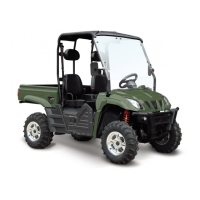
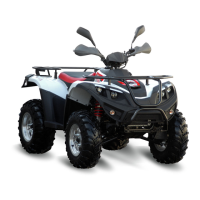
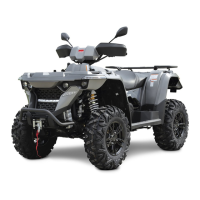


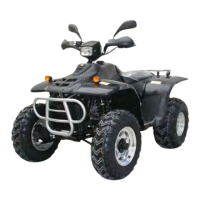





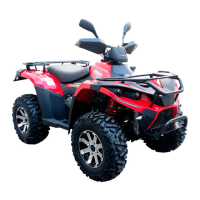
